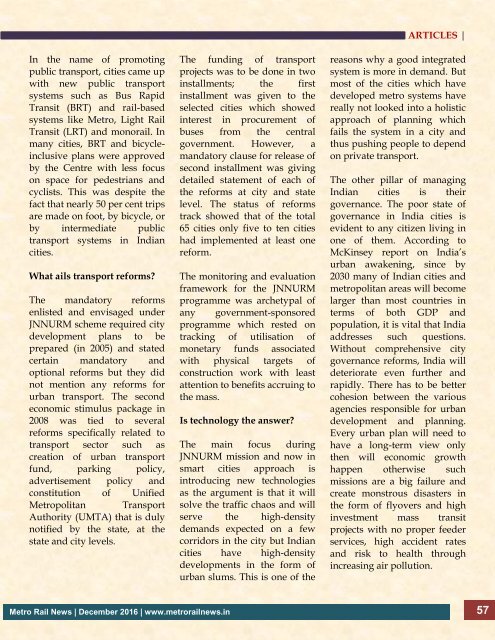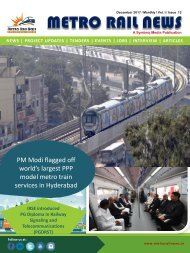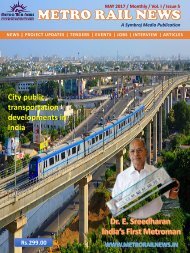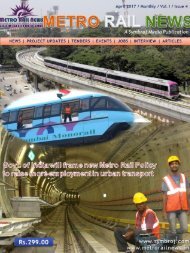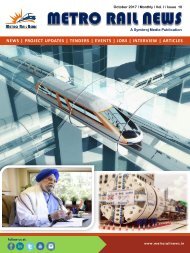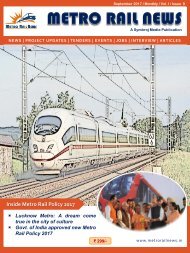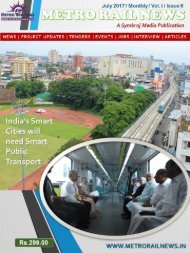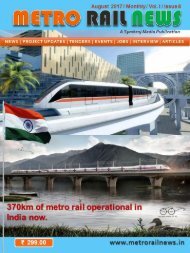Metro Rail News December 2016
You also want an ePaper? Increase the reach of your titles
YUMPU automatically turns print PDFs into web optimized ePapers that Google loves.
In the name of promoting<br />
public transport, cities came up<br />
with new public transport<br />
systems such as Bus Rapid<br />
Transit (BRT) and rail-based<br />
systems like <strong>Metro</strong>, Light <strong>Rail</strong><br />
Transit (LRT) and monorail. In<br />
many cities, BRT and bicycleinclusive<br />
plans were approved<br />
by the Centre with less focus<br />
on space for pedestrians and<br />
cyclists. This was despite the<br />
fact that nearly 50 per cent trips<br />
are made on foot, by bicycle, or<br />
by intermediate public<br />
transport systems in Indian<br />
cities.<br />
What ails transport reforms?<br />
The mandatory reforms<br />
enlisted and envisaged under<br />
JNNURM scheme required city<br />
development plans to be<br />
prepared (in 2005) and stated<br />
certain mandatory and<br />
optional reforms but they did<br />
not mention any reforms for<br />
urban transport. The second<br />
economic stimulus package in<br />
2008 was tied to several<br />
reforms specifically related to<br />
transport sector such as<br />
creation of urban transport<br />
fund, parking policy,<br />
advertisement policy and<br />
constitution of Unified<br />
<strong>Metro</strong>politan Transport<br />
Authority (UMTA) that is duly<br />
notified by the state, at the<br />
state and city levels.<br />
The funding of transport<br />
projects was to be done in two<br />
installments; the first<br />
installment was given to the<br />
selected cities which showed<br />
interest in procurement of<br />
buses from the central<br />
government. However, a<br />
mandatory clause for release of<br />
second installment was giving<br />
detailed statement of each of<br />
the reforms at city and state<br />
level. The status of reforms<br />
track showed that of the total<br />
65 cities only five to ten cities<br />
had implemented at least one<br />
reform.<br />
The monitoring and evaluation<br />
framework for the JNNURM<br />
programme was archetypal of<br />
any government-sponsored<br />
programme which rested on<br />
tracking of utilisation of<br />
monetary funds associated<br />
with physical targets of<br />
construction work with least<br />
attention to benefits accruing to<br />
the mass.<br />
Is technology the answer?<br />
The main focus during<br />
JNNURM mission and now in<br />
smart cities approach is<br />
introducing new technologies<br />
as the argument is that it will<br />
solve the traffic chaos and will<br />
serve the high-density<br />
demands expected on a few<br />
corridors in the city but Indian<br />
cities have high-density<br />
developments in the form of<br />
urban slums. This is one of the<br />
ARTICLES |<br />
reasons why a good integrated<br />
system is more in demand. But<br />
most of the cities which have<br />
developed metro systems have<br />
really not looked into a holistic<br />
approach of planning which<br />
fails the system in a city and<br />
thus pushing people to depend<br />
on private transport.<br />
The other pillar of managing<br />
Indian cities is their<br />
governance. The poor state of<br />
governance in India cities is<br />
evident to any citizen living in<br />
one of them. According to<br />
McKinsey report on India’s<br />
urban awakening, since by<br />
2030 many of Indian cities and<br />
metropolitan areas will become<br />
larger than most countries in<br />
terms of both GDP and<br />
population, it is vital that India<br />
addresses such questions.<br />
Without comprehensive city<br />
governance reforms, India will<br />
deteriorate even further and<br />
rapidly. There has to be better<br />
cohesion between the various<br />
agencies responsible for urban<br />
development and planning.<br />
Every urban plan will need to<br />
have a long-term view only<br />
then will economic growth<br />
happen otherwise such<br />
missions are a big failure and<br />
create monstrous disasters in<br />
the form of flyovers and high<br />
investment mass transit<br />
projects with no proper feeder<br />
services, high accident rates<br />
and risk to health through<br />
increasing air pollution.<br />
<strong>Metro</strong> <strong>Rail</strong> <strong>News</strong> | <strong>December</strong> <strong>2016</strong> | www.metrorailnews.in 57


